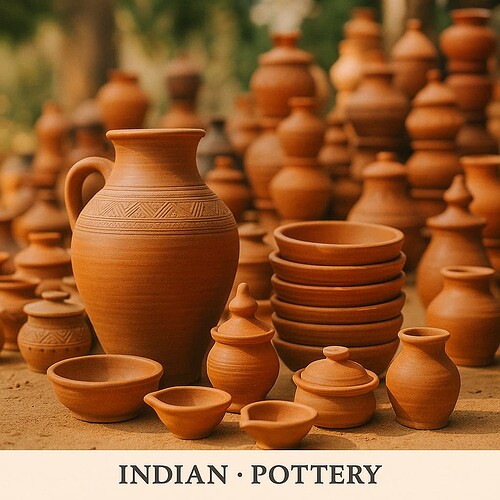Introduction:
India’s pottery tradition is one of the oldest in the world, tracing back to the Indus Valley Civilization. Despite this rich heritage, a significant portion of Indian potters today do not see a secure future in their craft. Once revered as essential artisans shaping daily life and rituals, potters now face an uncertain economic and social landscape that has led many to abandon pottery for alternative work. This report investigates the key reasons for this shift, highlighting systemic issues and exploring possible solutions.
1. Economic Challenges and Low Income
- Seasonal Demand: Pottery sales peak during festivals like Diwali (for diyas) or during the summer (for matkas), but slump during off-seasons.
- Low Retail Prices: Traditional pots often sell for just a few rupees, despite the labor involved. Margins are thin and unpredictable.
- Lack of Bulk Orders: Declining institutional or wholesale buyers has reduced stable income sources.
- Middlemen Exploitation: Many potters sell through intermediaries who take a large share of the profit, reducing artisans’ earnings.
2. Competition from Modern Materials
- Plastic and Metal Replacements: Consumers increasingly prefer plastic or steel containers over clay pots, citing durability and convenience.
- Industrial Ceramics: Factory-made ceramic wares are cheaper, mass-produced, and more consistent in quality.
3. Lack of Market Access and Exposure
- Geographical Isolation: Potters in remote areas struggle to reach urban or international buyers.
- Poor Marketing: Many artisans lack branding, packaging, or storytelling skills to appeal to modern consumers.
- Digital Divide: Few potters use e-commerce or social media due to lack of training, language barriers, or internet access.
4. Raw Material Scarcity and Environmental Constraints
- Clay Shortage: Urban development and mining have reduced access to high-quality clay.
- Environmental Restrictions: Legal limits on clay extraction and wood firing in some states make traditional pottery harder to sustain.
- Climate Risks: Unseasonal rains and heatwaves disrupt the drying and firing process.
5. Physical Strain and Health Issues
- Labor-Intensive Work: Pottery involves heavy lifting, long hours, and exposure to smoke and dust.
- Lack of Ergonomic Tools: Many potters still use manual wheels and rudimentary kilns.
- Limited Medical Care: Potters often lack access to healthcare or compensation for work-related injuries.
6. Lack of Innovation and Training
- Stagnant Designs: Without design education, many potters continue producing the same items, leading to market saturation.
- No R&D Support: Few craft clusters have access to new glaze formulas, mold techniques, or global trend data.
- Limited Collaboration: There’s minimal interface between traditional potters and modern designers or institutions.
7. Youth Disinterest and Generational Shift
- Low Prestige: Pottery is seen by many young people as old-fashioned and unrewarding.
- Better Alternatives: Urban jobs in delivery, retail, or construction pay more and are less labor-intensive.
- Migration: Younger generations move to cities for education and leave the family craft behind.
8. Policy Gaps and Implementation Barriers
- Limited Reach of Government Schemes: While programs like Kumhar Sashaktikaran Yojana exist, many potters don’t know how to access them.
- Corruption and Bureaucracy: Aid distribution can be delayed or mismanaged.
- No Long-Term Planning: Policies focus on tools, not on sustainability or market building.
9. Social Stigma and Identity Loss
- Caste-Based Limitations: Pottery is traditionally associated with lower-caste groups, which leads to stigma.
- Erosion of Community Identity: As families leave the profession, the shared cultural memory and collective craft knowledge begin to fade.
Conclusion India’s potters are at a crossroads. The decline in active practitioners is not due to lack of talent or tradition, but because of systemic neglect, market shifts, and socio-economic pressures. Unless addressed through holistic, inclusive, and sustained efforts—including design innovation, financial incentives, youth engagement, and market connectivity—the country risks losing one of its most ancient crafts. To keep the potter’s wheel spinning, we must reshape the environment around it.
Recommendations
- Expand access to modern kilns, tools, and ergonomic equipment.
- Create dedicated pottery zones with secure clay access and infrastructure.
- Launch rural pottery design labs and training hubs.
- Promote pottery through cultural tourism and public procurement (e.g., kulhars in railways).
- Incentivize pottery in school curriculums and skill-building programs.
- Encourage youth-led pottery enterprises with digital marketing support.
- Set up common e-commerce platforms and co-branding strategies.
Indian pottery can have a future—but only if we act decisively, respectfully, and collaboratively to ensure that the hands shaping the earth are not forgotten.
Prepared by: Famalth Research Desk (23 April 2025)
